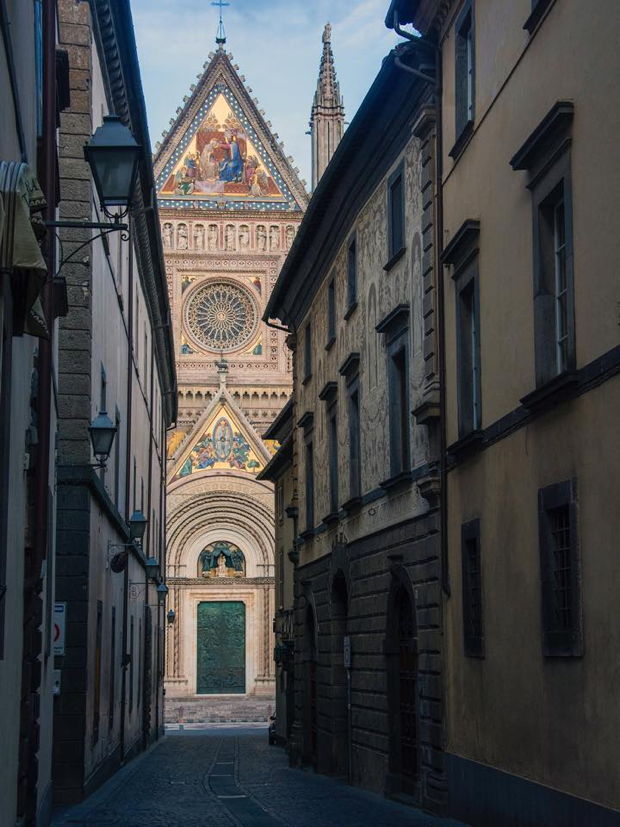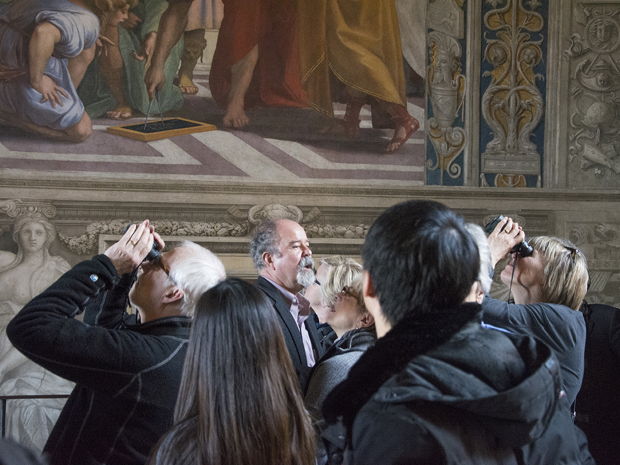I wish you could have been with us — gathered together in a restored 13th century convent, enjoying food and drink around the refectory table, discussing art and life.

This temporary learning community, sponsored by Christians in the Visual Arts (CIVA) and Gordon College's Studio for Art, Faith & History, was called together to consider, “Who Makes Art Work?” We came in with the understanding that in the period we would be studying — the early Renaissance in Italy — it was not just the artist, but a cohort made up of patrons, scholars, the local communities, and the artists, who together both made artwork and made art work. And there was the question: could this be a model for us today?
To see art work, to see art serve, not just to decorate our living spaces or make a statement in a museum or be used commercially was something of a new concept for me, though it resonated. I have often wondered if having a Makoto Fujimura painting in a place where I would see it often — my living room? (perhaps this one, Joy?) — could make me a better, more joyful, person.

Photo: Scott L. Wilson
I wonder if we give enough credit to what artwork present with us can do, corporately or personally. I heard N.T. Wright once describe his practice of taking an icon of Jesus with him on his travels and, upon entering a hotel room, placing it on the television set. He is asking the art to do work — to remind him of his purpose and to keep him from offending.
Wright carries his artwork with him. The artwork we were considering was in situ, in the place its intended audience would gather. It was designed “to help the people who come do what they have come to do,” in the words of Dr. John Skillen, director of the Studio for Art, Faith & History. Artwork in a church was designed and situated to aid and to inspire worship; that in a government building was done to stimulate good government; and in a guild house, to speak of the range and purpose of the guild’s craft.
Stepping into the convent of San Marco in Florence, we saw an even more specific expression of art done for a particular audience. Each individual cell has a personal fresco painted by Fra Angelico on a wall. Each monk lived with a specific scene from the life of Christ on which to meditate. In each cell meant for a novice, the frescos were images of the crucifixion. I confess (as a Protestant) to some discomfort at the thought of viewing an image of the crucifixion morning, noon, and night. I expect though that Paul, writing “For I resolved to know nothing while I was with you except Jesus Christ and him crucified,” (I Cor. 2: 2), would have agreed with the Dominican order’s theological advisors; this was the appropriate object for meditation at the beginning of a religious vocation.

Photo: Laurel Anderson
I was particularly captivated entering one of the cells to see a fresco of Jesus praying in the garden. Peter, James, and John were nearby fast asleep, but Mary and Martha were also included in the scene, painted wide awake. Mary was deep in contemplation (reading Scripture) and Martha was at work (praying). There was none of the opposition I often sense as I consider their story. Here they were united and collaborative in their watch. What would it mean for me to enter my kitchen each day and live with this image painted on the wall? What would it mean to my understanding of contemplation and work?
But this is a personal example, and we were asked to consider how artwork might be done to influence our contemporary culture, particularly as it relates to the church. Cam Anderson, Executive Director of CIVA and fellow trip participant, writes, “Regarding the church, increasingly worshipers want to experience mystery and metaphor, not just apologetic argument. They sense that the arts can help them with this.”

Photo: Scott L. Wilson
But does the church today work with artists to effect this? I was struck by Skillen’s statement that “today we privilege the artist genius but we give no way for an artist to make a living.” I think most of the artists I know would affirm this. This is true not just in our culture, but perhaps particularly in the church:
"...I see the inconsistency operating in the new appreciation of the arts and artists by the church. We applaud the creativity of the artist without committing ourselves to maintaining the livelihood of the artist. The artist enjoys being affirmed for his creative insight and genius, but stops short of allowing that creativity to be informed by the missional work of the people. Meanwhile, the training that young artists typically receive at Christian liberal arts institutions prepares them for a gallery-based system where few are likely to find gainful employment and full-time careers as practicing artists. Their vocational training all too often distances them from the communities of shared faith where they might find spiritual sustenance and fellowship. Nor does the not-entirely-unfounded stereotype of the struggling Christian artist – for whom the church may provide a support group – help to change the still-common church view of the irrelevance of the artwork for its own identity and liturgy." — John Skillen, from the preface to a forthcoming book with Hendrickson Publishers
Sitting in the spare sanctuary of my own campus church on Sunday, I wondered what images might be painted or hung on the walls (and ceiling?) to inspire us to worship, remind us of our purpose, and instruct us in the faith. What would we choose as our most dear themes to be reminded of each week? We have gratefully accepted beautiful temporary artwork from artists willing to volunteer their time and resources, but does this sustain them, or us? We’ve had a committee working to craft a written statement of mission; are we prepared to put resources into a visual statement of mission as well?
I think there are questions here for all of us. Thankfully neither we as individual Christians nor the artists are meant to wrestle with them alone. Organizations such as CIVA offer resources, connections to art and artists, and thoughtful engagement with these issues. And much has been written. Philip Ryken, president of Wheaton College, has a tongue-in-cheek but challenging essay, How to Discourage Artists in the Church and Fujimura writes extensively about the intersections of art and faith.
But perhaps what we can best do is to seek out and see art — particularly in this context, art by artists whose work is informed by their Christian faith. If necessary to appreciate the work, we may need help from the artist herself or from those who better understand it, as John Skillen helped our group to do in Italy. Finding ourselves in the presence of art can allow it to do the work it was designed to do.
Perhaps as we more fully see artwork as vital to our flourishing as human beings and as Christians, we will be inspired to put our time and resources into working with and supporting artists, and by God’s grace, find our faith, our lives, and our communities enriched by their work.
A special thank you to Scott L. Wilson and Laurel Anderson for generously permitting us to use their photographs from the trip.